The holiday season is fast approaching, and for eCommerce brands, that means one thing: Black Friday. In 2023, Black Friday sales reached a staggering $20.8 billion in the U.S. alone, marking a 5.5% increase from the previous year (Forbes). This shopping extravaganza is a fantastic chance to accelerate your sales, acquire new customers, and strengthen and reinforce your brand's visibility. Standing out in a vast pool of discounts and promotions can be a task. But here’s the deal: Launching campaigns unique to your brand helps. Here are five actionable tips to nail your Black Friday marketing campaign this year.
We've also added 20 examples of the best Black Friday marketing campaigns to fuel your inspiration. Let’s dive in!
Five strategies to kickstart your Black Friday marketing
1. Kick Off the Hype Early: Tease the Deals The anticipation for Black Friday begins long before the event itself, with savvy brands building excitement weeks in advance. Engaging your audience early can make a huge difference when the big day arrives.
Example: In 2021, Allbirds teased their eco-friendly footwear deals with an engaging campaign that started two weeks before Black Friday. They shared exclusive previews of upcoming discounts with their email subscribers, creating a buzz that led to a significant increase in sign-ups and pre-sale excitement. When the deals finally dropped, Allbirds saw a noticeable surge in conversions.
Pro Tip: Leverage countdown timers, teaser emails, and social media sneak peeks to stir up excitement. Build a sense of anticipation so your customers are primed and ready when the big day arrives.
2. Reward Your Most Loyal Customers
Exclusive deals for your loyal customers can foster deeper relationships and encourage repeat purchases during Black Friday. You can use video banners on your website that show your products with discounts and rewards using Shoppable Videos.
Example: In 2022, Tarte Cosmetics excelled by offering their loyalty program members early access to Black Friday deals, plus additional discounts layered on top of standard promotions. This strategy not only made their loyal customers feel valued but also boosted early sales, driving higher overall revenue.
Pro Tip: Consider tiered discounts for loyalty program members. For instance, offer larger discounts or earlier access to your top-tier customers to make them feel even more special.
shoppable video banner
3. Create a Sense of Urgency with Flash Sales
Urgency can be a powerful motivator during Black Friday. Flash sales and limited-time offers tap into FOMO, encouraging quick purchases.
Example: In 2021, Fenty Beauty ran a series of flash sales, offering deep discounts on select products for just a few hours at a time. They announced these sales on social media and through email blasts, using countdown timers to amplify the urgency and drive conversions.
Pro Tip: Utilize countdown timers on your website and in emails to highlight the limited-time nature of your offers. This can significantly increase conversion rates by triggering impulse buying behavior.
4. Boost Sales with Product Bundling
Bundling products can enhance the perceived value and drive up your average order value (AOV) during Black Friday.
Example: In 2021, Amazon effectively used bundling by offering Echo devices with other smart home products at a discounted rate. This approach not only moved more inventory but also offered customers a compelling reason to increase their spend.
Pro Tip: When bundling, choose products that complement each other well. Offering a slight discount on the bundle versus buying items individually can make the deal too good to pass up.
5. Amplify Your Reach with User-Generated Content
User-generated content (UGC) and social proof can be particularly persuasive when consumers are looking for the best deals. Generating UGC content is easier than ever today. Tools like Whatmore’s Studio auto-fetch all the product details from a product URL, either from Shopify, Amazon, etc, and then create content for you. It could be a customer testimony or a voiceover, whatever serves your goal.
Example: In 2022, Alo Yoga harnessed the power of UGC by sharing customer photos and testimonials across social media during Black Friday. This not only built trust but also created a sense of community, encouraging even more customers to share their experiences and boosting brand engagement.
Pro Tip: Encourage customers to share their purchases on social media with a branded hashtag. Repost these during Black Friday to enhance engagement and leverage social proof.
20 Black Friday Marketing Ideas to Inspire You
In this section, we’ll dive into some of the most successful Black Friday marketing campaigns, analyzing what these brands did right and how their strategies paid off. From leveraging urgency to driving customer loyalty, each campaign offers valuable insights that you can apply to your own Black Friday marketing strategy.
1. Adidas: Limited-Time Sales on Exclusive Products + Targeted Email Campaign
What They Did Right: Adidas used the allure of exclusivity and urgency by launching limited-time sales on their exclusive product lines. Using words like ‘Ends Tonights’’ helps create urgency.Their targeted email campaign effectively informed their audience about these time-sensitive deals, fostering a strong sense of FOMO (Fear of Missing Out).
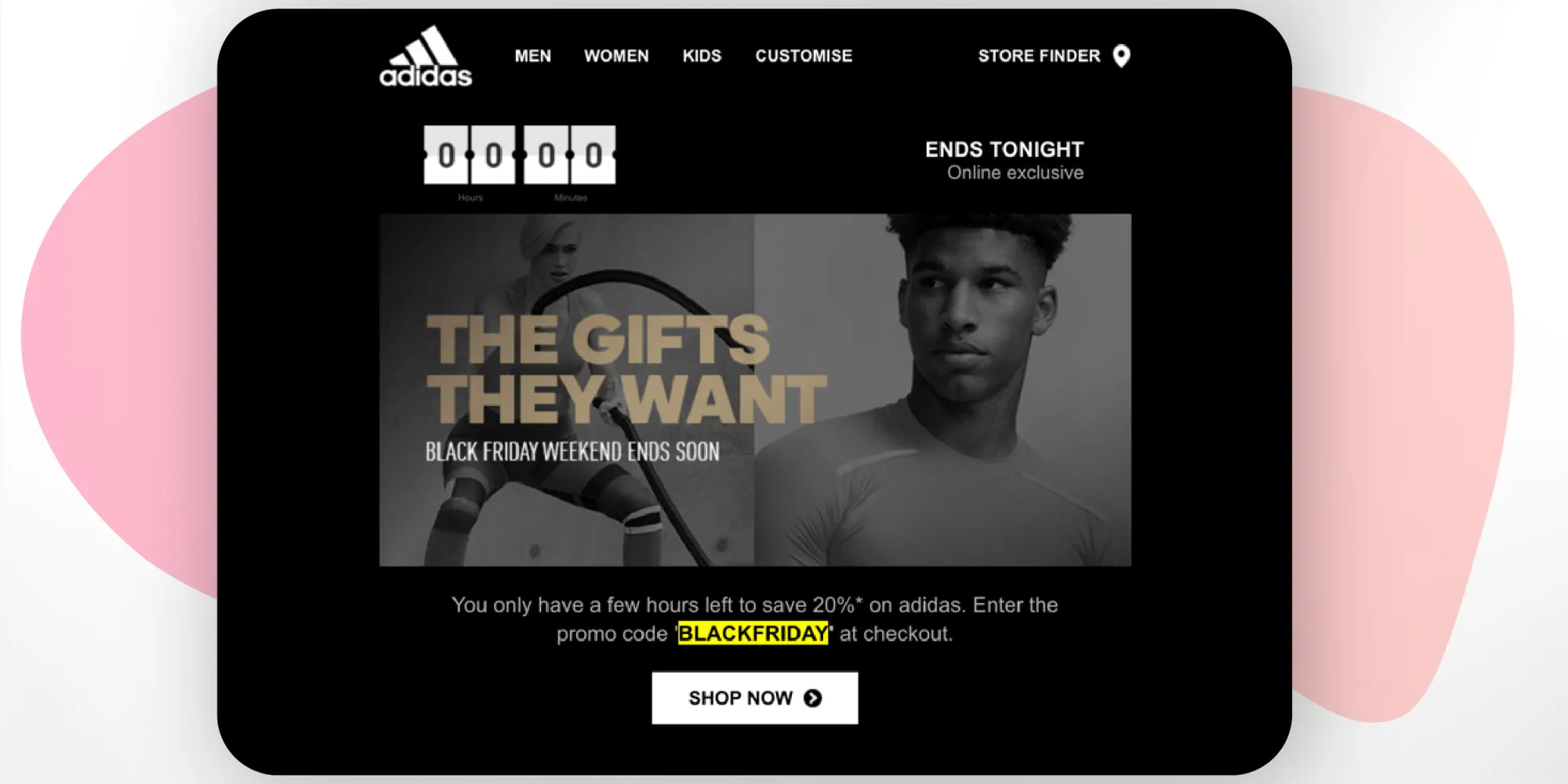
Benefit: This strategy not only drove immediate sales but also strengthened customer engagement by making subscribers feel like they were part of something special. Basically, offering exclusivity. The urgency created by the flash sales led to quick purchasing decisions and higher conversion rates.
2. Warby Parker: Free Second Pair of Glasses
What They Did Right: Warby Parker’s Black Friday campaign was simple yet effective—offering a free second pair of glasses with every purchase. This not only added value to the customer but also encouraged higher order volumes. They also offer a 15% discount when you buy more than 2 products.
Benefit: By giving customers a tangible incentive, Warby Parker increased average order value (AOV) and drove repeat purchases. The promotion also positioned the brand as generous and customer-focused, enhancing brand loyalty.
3. Macy’s: Personalized Promotions Highlighting Favorite Brands
What They Did Right: Macy’s sent out personalized email promotions highlighting discounts on customers’ favorite brands. By analyzing past purchases, they were able to offer highly relevant deals that resonated with each recipient.
Benefit: The focus on favorite brands increased customer loyalty and drove significant sales, as customers were more inclined to purchase products from brands they `already loved.
4. Allbirds: Conscious Consumption Black Friday Campaign
What They Did Right: Allbirds took a unique stance on Black Friday 2019 by closing their Covent Garden store in London, promoting conscious consumption under the tagline, “Black Friday? We’re Not Buying It.”
Instead of traditional retail, they hosted community activities like live music and craft workshops. They also launched three exclusive sneakers for Black Friday, offering customers the choice to engage in experiences, make a purchase, or both.
Benefit: This approach helped Allbirds stand out by emphasizing sustainability while still offering exclusive products. The campaign strengthened customer engagement, built community, and enhanced brand loyalty, reinforcing Allbirds' image as a conscious and innovative brand.
5. Best Buy: Doorbuster Deals with Multi-Channel Advertising
What They Did Right: Best Buy’s Black Friday campaign featured doorbuster deals that were heavily advertised across both online and offline channels, ensuring maximum reach and visibility.
Benefit: The widespread promotion created buzz and drew large crowds, both in-store and online. By leveraging multiple channels, Best Buy reached a broader audience, driving significant foot traffic and online sales.
6. Lululemon: "We Made Too Much" Campaign
What They Did Right: Lululemon's "We Made Too Much" campaign strategically extended the appeal of Black Friday Cyber Monday (BFCM) by offering ongoing discounts even after the holiday rush.
By creating a dedicated section for discounted items, Lululemon kept the excitement of bargain hunting alive, encouraging customers to keep shopping beyond the traditional BFCM period. This campaign also helped the brand efficiently clear out excess inventory without needing to heavily promote new sales.
Benefit: This approach benefited Lululemon by maintaining customer engagement long after Black Friday, driving continuous traffic to their website. Simultaneously, Lululemon managed to efficiently move stagnant inventory, improving overall inventory turnover and making room for new collections.
7. Adidas: Targeted Social Media Ads Leading to Black Friday Landing Pages
What They Did Right: Adidas used targeted ads on social media platforms that directed users to dedicated landing pages. These pages were optimized for conversions with clear calls to action (CTAs) and exclusive deals.
Benefit: This strategy ensured that Adidas reached the right audience with the right message at the right time. The targeted approach increased ad relevance, resulting in higher engagement and conversion rates.
8. Amazon: Week-Long BFCM Event with Daily Deals
What They Did Right: Amazon extended BFCM into a week-long event with daily deals and lightning sales. This strategy kept customers coming back to the site multiple times throughout the week.
Benefit: By spreading out the deals, Amazon maintained high traffic and sustained sales momentum throughout the entire week. The daily deals created a sense of excitement and urgency, encouraging repeat visits and multiple purchases.
9. Revolve: Influencer-Driven Promotions Aligned with Black Friday Sales
What They Did Right: Revolve partnered with influencers to promote their Black Friday deals. The influencers created content that aligned with Revolve’s brand and highlighted the Black Friday sales, driving engagement and traffic.
Benefit: The influencer-driven approach added credibility and expanded Revolve’s reach to the influencers' followers. This strategy not only increased brand visibility but also drove higher conversions by tapping into the trust and influence these content creators had over their audiences.
10. Patagonia: Reversible Poem Campaign
What They Did Right: Patagonia stayed true to its core values by running an anti-Black Friday campaign with a strong social message. They published a reversible poem that highlighted the climate crisis, creatively engaging their audience with a call to action for responsible consumerism. This innovative approach aligned with their “Buy Less, Demand More” ethos, making their stance against mindless consumption clear.
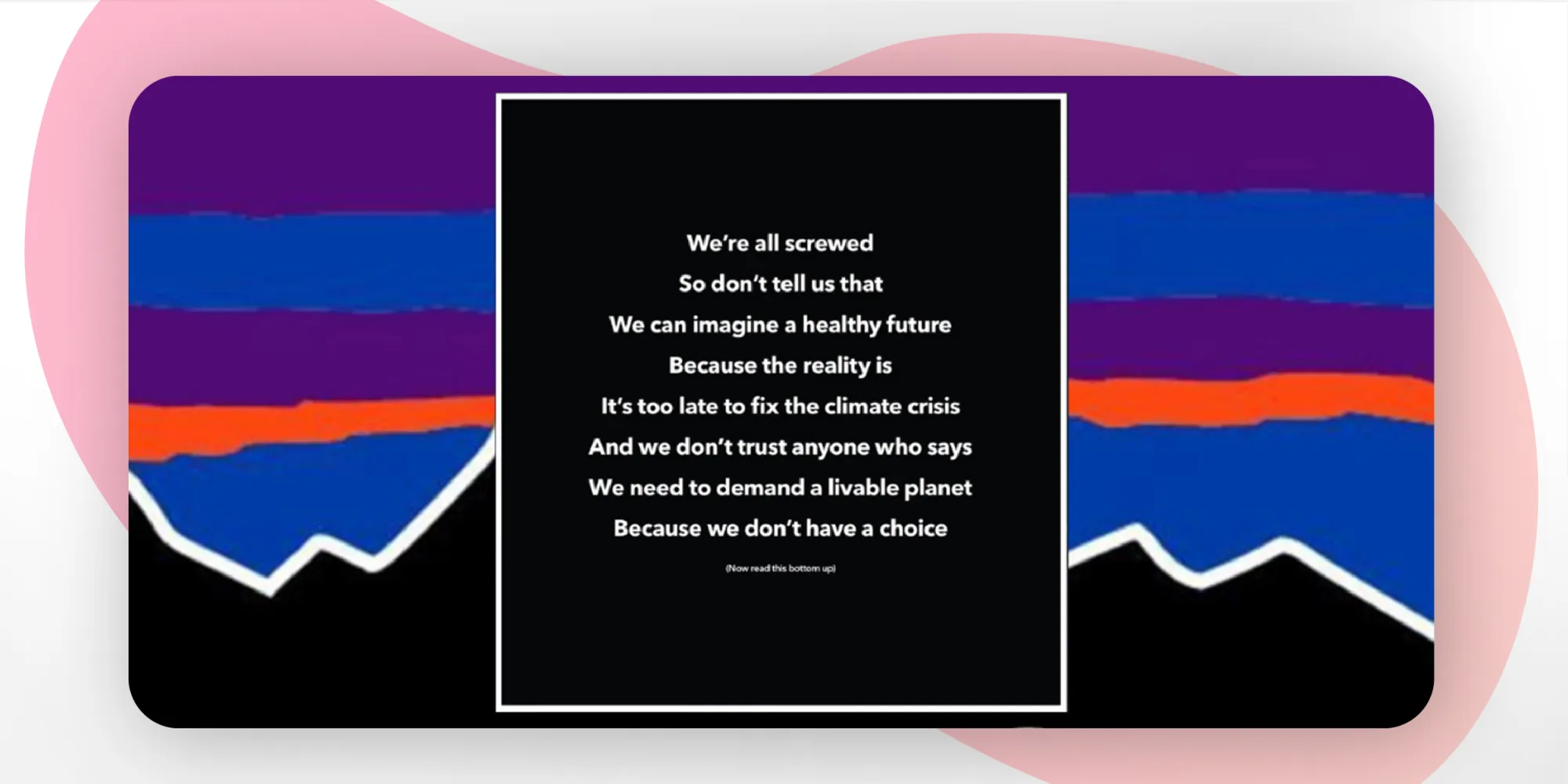
Benefit:
This campaign resonated with Patagonia's target audience, enhancing their brand authenticity and commitment to environmental advocacy. The poem went viral on social media and was featured in the New York Times, boosting brand visibility. By staying true to their values, Patagonia strengthened their relationship with loyal customers, likely increasing sales among those who share their environmental concerns.
11. Casper: Flash Discounts on Mattresses + Free Bedding Perks
What They Did Right: Casper offered flash discounts on their mattresses and sweetened the deal by including free bedding with each purchase.
Benefit: The added value of free bedding made the deal more enticing, increasing conversions. The flash discount created urgency, while the free perks encouraged higher-order values.
12. Francesca's: Tiered Discount Strategy for Black Friday Cyber Monday
What They Did Right: Francesca's implemented a tiered discount strategy during Black Friday Cyber Monday, offering customers progressively larger discounts based on their total purchase amount. For example, customers could save 50% on orders over $150, and 40% on orders over $100.
This strategy incentivized shoppers to spend more in order to unlock higher discounts, effectively driving up the average order value (AOV).
Benefit: The tiered discount approach not only encouraged higher spending but also created a sense of urgency as customers aimed to maximize their savings.
This helped Francesca's boost overall sales during the BFCM period, while also appealing to a wide range of shoppers with different budgets.
The clear and straightforward discount structure made it easy for customers to understand and engage with the promotion, leading to increased conversions.
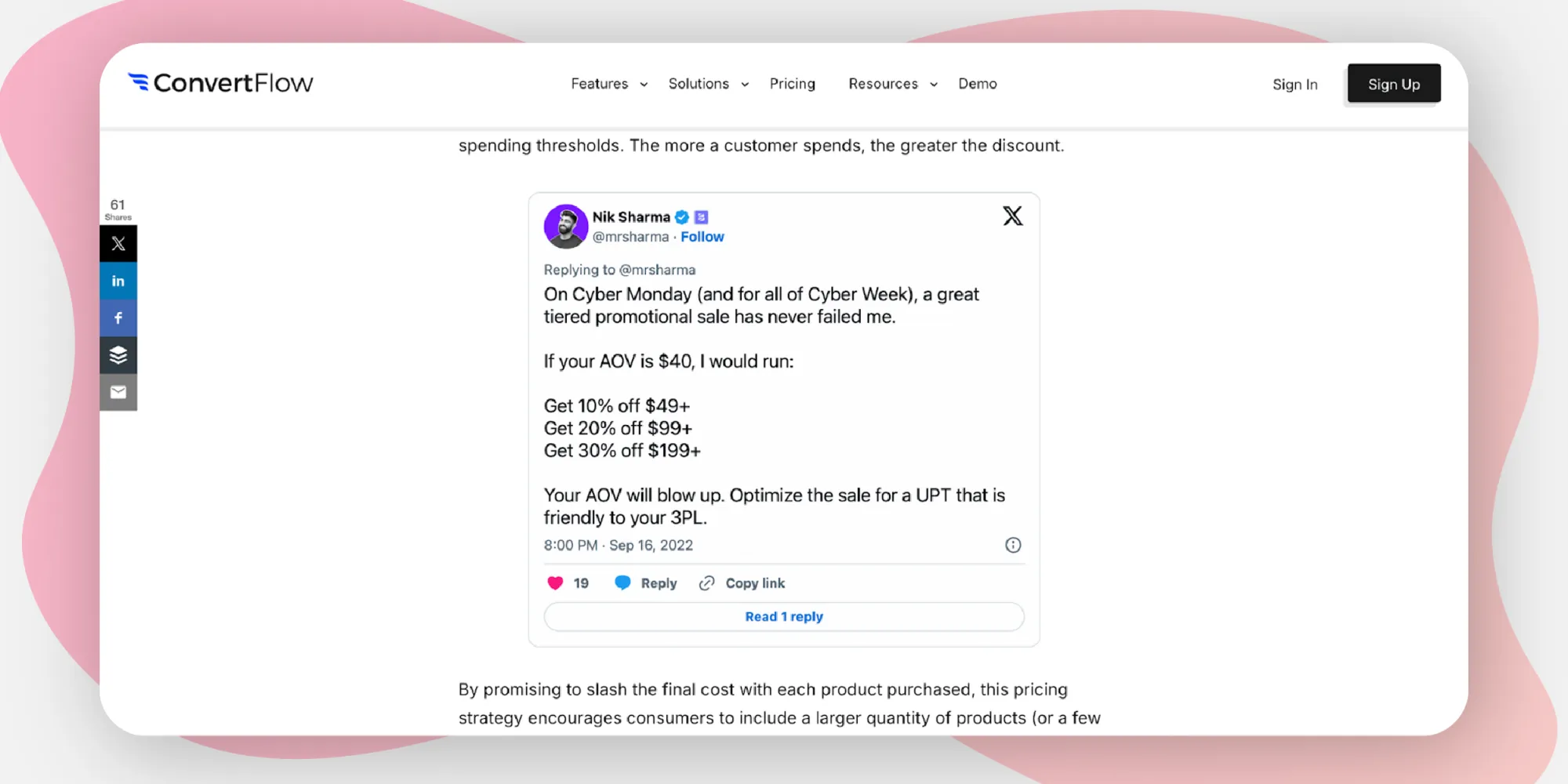
13.Art of Play: Limited-Time Mystery Collection
What They Did Right: Art of Play introduced a limited-time mystery collection during Black Friday Cyber Monday, offering a unique and engaging shopping experience. Customers were intrigued by the mystery element, as they didn't know exactly what they were purchasing until they received their orders. This sense of surprise and exclusivity made the collection highly appealing, driving curiosity and engagement.
Benefit: The mystery collection created a buzz around Art of Play's BFCM campaign, encouraging impulse purchases and boosting sales. The limited-time nature of the offer added a sense of urgency, motivating customers to act quickly. The mystery element enhanced the shopping experience, making it memorable and fun, which likely increased customer loyalty and word-of-mouth promotion.
14. Cards Against Humanity: Anti-Black Friday Campaign
What They Did Right: Cards Against Humanity took a bold and humorous approach to Black Friday by running an anti-consumerism campaign. Instead of offering discounts, they did the opposite—raising their prices on Black Friday.
This tongue-in-cheek strategy was designed to critique the rampant consumerism associated with the holiday. In previous years, they’ve run similar unconventional campaigns, such as charging customers $5 to “buy nothing” or slashing prices by 99%, only to poke fun at traditional sales tactics.
Benefit: This anti-Black Friday approach not only aligned with the brand's irreverent and satirical image but also generated significant buzz and media attention. By standing out in a sea of discounts and sales, Cards Against Humanity reinforced its brand identity, appealed to its core audience, and created a memorable and shareable experience.
The campaign also highlighted the brand’s commitment to challenging consumerism, which resonated with customers who appreciate their unique brand of humor and values.
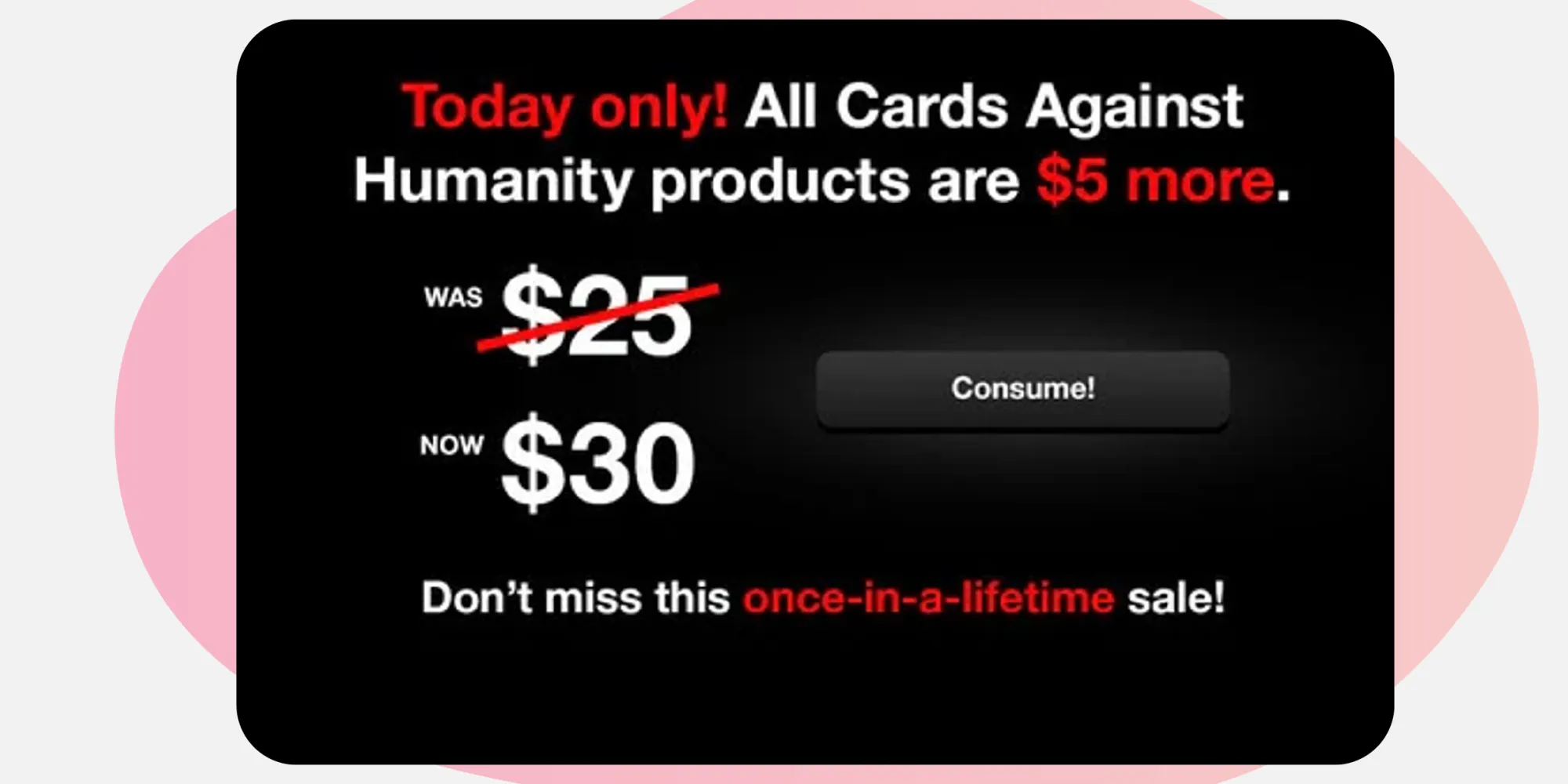
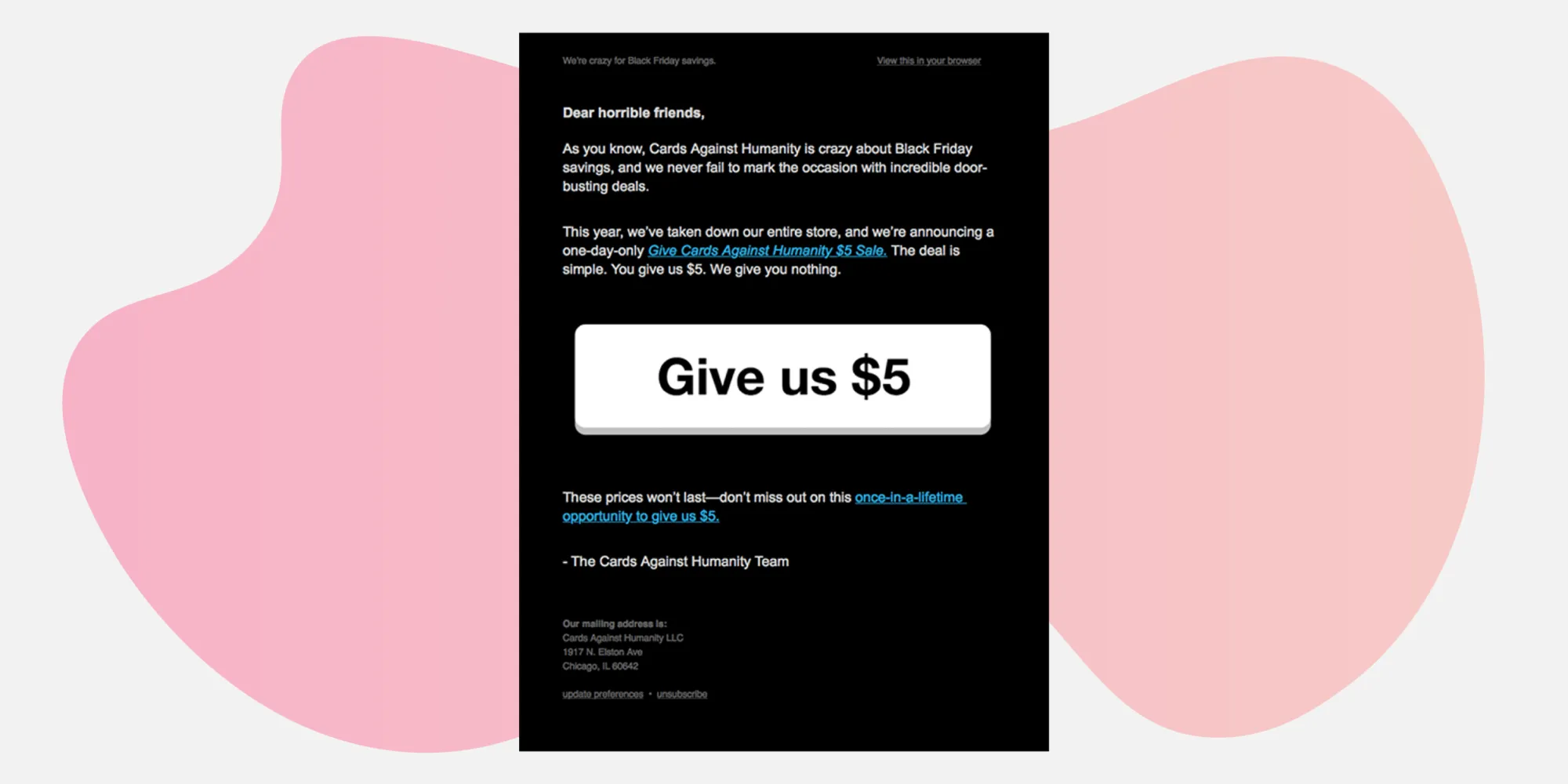
15. Target: Synchronizing In-Store and Online Deals
What They Did Right: Target ensured a seamless shopping experience by synchronizing their in-store and online deals during Black Friday, allowing customers to shop however they preferred.
Benefit: The unified approach increased customer satisfaction and convenience, leading to higher sales both in-store and online. Target’s strategy also minimized confusion and ensured a consistent brand experience across all touchpoints.
16. Macy’s: Early Access for Credit Cardholders
What They Did Right: Macy’s offered early access to their Black Friday deals exclusively for credit cardholders, adding an element of exclusivity.
Benefit: This strategy drove early sales and incentivized customers to sign up for Macy’s credit card, enhancing customer loyalty. The early access also helped Macy’s spread out the shopping traffic, reducing strain on their systems and improving the shopping experience.
17. H&M: Heavily Discounted Holiday Collections + Retargeting Ads
What They Did Right: H&M offered significant discounts on their holiday collections and used targeted retargeting ads to bring back customers who had shown interest but hadn’t yet made a purchase.
Benefit: The discounted holiday collections drove seasonal sales, while the retargeting ads helped recapture lost sales, increasing overall conversions. H&M’s strategy also ensured that their brand stayed top-of-mind throughout the Black Friday period.
18. Zappos: Extended Return Policies and Free Shipping
What They Did Right: Zappos effectively capitalized on convenience and customer satisfaction during Black Friday by offering contactless shopping, 24/7 customer service, a 365-day return policy, and free returns. They also promoted budget-friendly gift options and featured a wide range of products, ensuring there was something for everyone. Additionally, they made gift-giving easy with the option of physical or digital gift cards.
Benefit: This strategy enhanced the shopping experience, making it easy and stress-free for customers. The focus on convenience, wide product selection, and flexible return policies helped Zappos attract a broad audience, increase sales, and boost customer loyalty during the highly competitive Black Friday period.
19. Under Armour: Bundled Fitness Gear with Loyalty Discounts
What They Did Right: Under Armour bundled fitness gear and offered special discounts to loyalty program members during Black Friday, rewarding their most engaged customers.
Benefit: The bundled products increased average order value, while the loyalty discounts reinforced customer retention. This approach ensured that Under Armour’s most loyal customers felt appreciated, driving repeat purchases.
20. Wayfair: Home Décor Flash Sales + Emphasis on Email and Social Media
What They Did Right: Wayfair focused on home décor flash sales promoted heavily through email and social media. The deals were time-sensitive, creating urgency.
Benefit: The flash sales, combined with effective promotion, drove high levels of engagement and conversions. Wayfair’s emphasis on email and social media ensured that their deals reached a wide audience, maximizing the impact of their Black Friday marketing campaign.
Conclusion
Building the perfect Black Friday campaign doesn’t happen overnight, but with these strategies, you’re well on your way to creating a standout campaign that boosts your sales and delights your customers. Remember, the key is to start planning early, focus on your loyal customers, and use urgency, bundling, and social proof to your advantage.
Ready to crush your Black Friday marketing goals?






